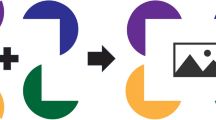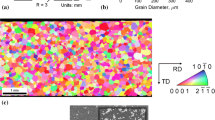Abstract
The ASM Micrograph Database is a growing online collection of more than 4000 micrograph images and associated data, published by ASM International, in cooperation with the International Metallographic Society. Available on a subscription basis, the emphasis of the collection is on micrographs for industrially important alloys. Information captured for each image includes material designation and composition, processing and service history, metallographic preparation/technique, magnification, significance of each microstructure, selected properties data, and other relevant data. Users can search and browse the database to examine images, view typical and optimal structures, and compare the effects of alloying or heat treating regimes on microstructures. As the database continues to grow and evolve, it will reflect the newest processes and imaging techniques (additive manufacturing, 3D tomography, etc.), and expanded alloy coverage, with an increased emphasis on multi-scale microstructure representations.
Similar content being viewed by others
Explore related subjects
Discover the latest articles, news and stories from top researchers in related subjects.Avoid common mistakes on your manuscript.
Introduction
“More than any other attribute, microstructure exerts a controlling influence over the final properties and performance of a material. With clear interpretation and a sound understanding, microstructure can be exploited to provide outstanding mechanical, electrical, magnetic, or chemical properties. Conversely, insufficient attention to control of microstructure can lead to unpredictable properties, inconsistent behavior, and material failure”, commented Ryan M. Deacon, editor of Metallography, Microstructure, and Analysis (MMA), in the journal’s inaugural issue [1].
Materials are a critical component to the development of new technologies, and an understanding of new microstructures is critical to material development. In response to the increasing importance of advanced material development and evolved technology, the U.S. government launched the Materials Genome Initiative (MGI) in 2011, with the goal of providing a framework to support discovery, manufacturing, and deployment of advanced materials “twice as fast, at a fraction of the cost” [2]. Access to microstructure data linked to process and property data supports the goals of MGI, and the ASM Micrograph Database has the potential to help fulfill this need.
Background
This database, originally named the ASM Micrograph Center, was developed in 2003 and 2004 under the guidance of an ASM editorial advisory committee with input from other interested member groups, including the International Metallographic Society (IMS), the ASM Materials Properties Database Committee (MPDC), and the ASM Technical Books Committee. The initial collection was made possible thanks to broad-based involvement by members of ASM International who participated in the contribution and review of micrographs and supporting data. Today, the collection is a dynamic database [3–5] that will continuously expand to meet the changing needs of current and future ASM members, and anyone interested in the art and science of metallography and material characterization.
Using the Database
From the Micrograph Database product homepage (Fig. 1), users can easily search and browse the entire database, and link to additional information of interest. The toolbar includes a Quick Search feature and a link to the Advanced Search page. The left panel contains the general schema represented as a tree-like structure, allowing users to browse the database by material category. The right panel features an image carousel, providing prospective consumers with a snapshot view of example micrographs. The homepage also includes quick links to more detailed information about the database, new content additions, micrograph submission and subscription details, and feedback. The Advanced Search function (Fig. 2) provides an easy way for users to find micrographs of interest by specifying multiple criteria. A pre-defined search feature enables users to quickly select specific conditions, product forms, and material groups to find micrographs meeting those criteria.
Organization of the Database
The database has been organized into three separate tables:
-
Micrograph data table—Contains high-resolution images and all pertinent details about the micrographs,
-
Micrographs table—Groups all similar materials together so that users can see the data in an organized fashion,
-
Micrograph Series table—Contains images submitted together, which tells the story about a specific grade of a material.
The tables seamlessly interact with each other, providing the best possible user experience (Fig. 3). General schema seen in the left tree panel and database record counts by material category, are shown below and in Figs. 4 and 5:
-
General (7 records)
-
Ceramic (198 records)
-
General (7)
-
Boride-base material (1)
-
Carbide-base material (47)
-
Nitride-base material (12)
-
Oxide-base material (131)
-
-
Composite (189 records)
-
Natural (6)
-
Polymer matrix (183)
-
General (129)
-
Thermoplastic matrix (21)
-
Thermoset matrix (33)
-
-
-
Ferrous (2183 records)
-
General (1)
-
Cast iron (298)
-
Iron alloy (40)
-
Iron-base superalloy (33)
-
Steel (1811)
-
-
Non-ferrous (1490 records)
-
Al (426)
-
Co (4)
-
Cu (447)
-
Pb (34)
-
Mg (52)
-
Miscellaneous (28)
-
Ni (27)
-
Refractory and reactive (56)
-
Superalloy (135)
-
Ti (261)
-
Zn (26)
-
-
Polymer (1 record)
At the record level, the following attributes have been assigned:
-
Micrograph image (including image name and scale),
-
Material details (name, type, alternate names, composition, condition, product form, properties, description),
-
Image details (image code, photo method and details, etchant, original magnification),
-
Links to a series, if applicable,
-
Links to a summary table containing all micrographs showing the same material, if applicable,
-
Keywords,
-
Contributor information,
-
Source details.
Summary Table
The “Micrographs” table groups similar materials together so that users can view the data in an organized fashion. Figure 6 illustrates how a few natural composites are grouped together in a summary table. Each individual record from the summary table will lead to the record itself and its specific attributes.
Micrographs Series Table
The “Micrograph Series” table contains images submitted together, which tells the story about a specific grade of a material. Figure 7 shows 3 individual records of thermoplastic matrix carbon fiber reinforced all linked as a series.
Software Platform
The original software for the application was developed by Granta Design, based on their Cambridge Engineering Selector (CES) software. The software platform was upgraded from CES to GRANTA MI version 6 in 2013, and to MI version 7 earlier this year. In addition to general performance and usability improvements, the latest version of the software includes enhancements specific to the Micrograph Database. The search improvements are the most significant. A Quick Search for Stainless Steel, for example, provides a total of 139 results, 133 results in the Micrographs Data table, and 6 results in the Micrograph Series table. After running a search, a user can click on any record to view the specific record details (Fig. 8).
Future Direction
The ASM Micrograph Database currently represents an authoritative, comprehensive library of micrographs and related data used by industry, academia, and government. Near-term content additions will include a selection of micrographs from the Metallography, Microstructure, and Analysis (MMA) journal, published by Springer, plus peer-reviewed database submissions. The Computational Materials Data Network initiative—founded by ASM—and associated projects may provide future content for the Micrograph Database, and new ways to utilize the data to support advanced material research and development.
References
http://springerlink.bibliotecabuap.elogim.com/article/10.1007/s13632-012-0003-2/fulltext.html. Accessed June 2015
https://www.whitehouse.gov/mgi. Accessed June 2015
http://www.asminternational.org. Accessed June 2015
http://www.asminternational.org/materials-resources/online-databases. Accessed June 2015
http://mio.asminternational.org/mgd/. Accessed June 2015
Acknowledgments
The authors wish to acknowledge the Micrograph Center Editorial Advisory Committee (EAC), and all past and present contributors to the database. Deep appreciation is expressed to IMS and the IMS Database Subcommittee for their expert guidance and support. The authors would also like to thank Springer for allowing ASM to include micrograph selections from Metallography, Microstructure, and Analysis (MMA) in the ASM Micrograph Database.
Author information
Authors and Affiliations
Corresponding author
Rights and permissions
About this article
Cite this article
Lupulescu, A., Flowers, T., Vermillion, L. et al. ASM Micrograph Database™. Metallogr. Microstruct. Anal. 4, 322–327 (2015). https://doi.org/10.1007/s13632-015-0212-6
Received:
Accepted:
Published:
Issue Date:
DOI: https://doi.org/10.1007/s13632-015-0212-6












